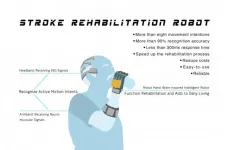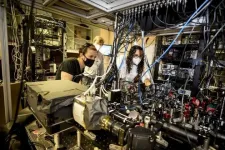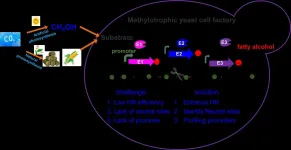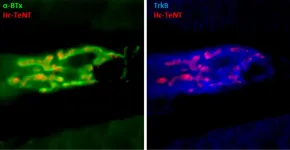(Press-News.org) A new study from Queen Mary University of London has demonstrated that immune cells can be stimulated to assemble into special structures within pancreatic cancer such that, at least in a pre-clinical model, researchers can demonstrate an improvement in the efficacy of chemotherapy.
The body's immune system is a critical defence against illness such as infections, as has been highlighted by the recent COVID-19 pandemic. The same immune system can also help us fight cancer. However, pancreatic cancer is different; a key feature of this cancer type is that the pancreatic cancer cells are surrounded by a dense, impenetrable barrier known as the stroma, which often blocks the access of immune cells to the tumour. For this reason, immunotherapies - drugs that harness the power of the body's immune system to kill cancer cells - have shown limited success in the treatment of pancreatic cancer, whilst they are effective in fighting other cancer types including skin and lung cancer.
Research has found that in some patients with pancreatic cancer, immune cells can assemble into clusters known as tertiary lymphoid structures (TLS) within the stroma, which are associated with improved survival outcomes in patients. However, TLS do not form naturally in all patients with pancreatic cancer. With this in mind, in this study the team set out to investigate the structure and role of TLS in pancreatic cancer when present, and to evaluate their anti-tumour activity.
The research was published in Cellular and Molecular Gastroenterology and Hepatology, and funded by Cancer Research UK, Pancreatic Cancer Research Fund and Medical Research Council.
To determine the presence of TLS within human pancreatic cancer, the team analysed tissue samples donated by patients to the Pancreatic Cancer Research Fund Tissue Bank. In this study, TLS were defined by the presence of tissue zones rich in B cells, T cells and dendritic cells - three cell types that have an important role in the immune response. By using specialised staining techniques to visualise the different cell types present within the samples, the team found that TLS were only in a third of patients whose samples were analysed.
To study the development of TLS in pancreatic cancer, the team generated a pre-clinical murine model of pancreatic cancer. TLS were not present in the model initially; however, following the injection of two signalling proteins (known as lymphoid chemokines) into the tumours of the mice, B cells and T cells infiltrated into the tumour site and assembled into TLS.
TLS induction can improve the effectiveness of chemotherapy
The team then combined the chemokine injection with administration of gemcitabine - a chemotherapy commonly used in the treatment of pancreatic cancer patients. The combination of gemcitabine and chemokine injection resulted in smaller tumours in mice, an effect that was not achieved by either treatment alone.
Hemant Kocher, Professor of Liver and Pancreas Surgery at Queen Mary University of London and consultant at Barts Health NHS Trust, who led the study, said: "Pancreatic cancer is known as a cold tumour, which means it does not have many immune cells near the cancer trying to fight it. In this study we have shown that immune cells can not only be harnessed but also made to assemble into TLS within a pre-clinical model of pancreatic cancer to make chemotherapy more effective."
"Formation of TLS is critical in mounting the anti-tumour response close to the tumour to overcome the problem posed by the barrier of the stroma. These findings suggest that combining chemotherapy with appropriate immunotherapy to stimulate immune cells in the tumour microenvironment could be used to tailor more personalised treatments against pancreatic cancer."
The anti-tumour activity seen after TLS formation in the pre-clinical model was associated with B cells triggering the activation of dendritic cells, which is required for the initiation of an immune response. The findings suggest that lymphoid chemokines, when used in combination with chemotherapy, may represent a viable therapeutic strategy for promoting an anti-tumour immune response that could lead to better clinical outcomes.
As this study used a mouse model, further research is now required to determine whether the same outcomes can be observed in other experimental models and in patients. The team believe that a more detailed understanding of TLS formation may aid in the development of personalised therapies that can harness the potential of the body's own immune system to fight cancer.
INFORMATION:
Research paper: 'Pancreatic cancer chemotherapy is potentiated by induction of tertiary lymphoid structures in mice'. Francesca R. Delvecchio, Rachel E.A. Fincham, Sarah Spear, Kairbaan Hodivala-Dilke, Melania Capasso, Hemant M. Kocher. Cellular and Molecular Gastroenterology and Hepatology. DOI 10.1016/j.jcmgh.2021.06.023
Available here: https://www.cmghjournal.org/article/S2352-345X(21)00138-7/fulltext
Coral reefs are a favorite spot for scuba divers and are among the world's most diverse ecosystems. For example, the Hawaiian coral reefs, known as the "rainforests of the sea," host over 7,000 species of marine animals, fishes, birds and plants. But coral reefs are facing serious threats, including a number of diseases that have been linked to human activity.
To understand the connection between human activity and a type of tumorlike disease called growth anomalies (GAs), researchers at the National Institute of Standards and Technology (NIST) have collaborated with the U.S Geological Survey (USGS) and the National ...
ATLANTA--The American College of Rheumatology (ACR), in partnership with the Vasculitis Foundation (VF), released three new guidelines for the treatment and management of systemic vasculitis. Vasculitis is a group of about 20 rare diseases that have inflammation of blood vessels in common, which can restrict blood flow and damage vital organs. The three guidelines cover six forms of vasculitis, and a fourth guideline on Kawasaki disease will be released in the coming weeks.
"Many rheumatologists may have limited experience caring for patients with these diseases," ...
Strokes, which occur when the blood supply to part of our brain is interrupted or reduced, are the leading cause of death and disability in the adult population. Among the patients who survive, 75% will experience difficulties carrying out daily activities independently and need long-term functional exercises and rehabilitation. But the outcomes using traditional rehabilitation equipment are poor. In addition, the motivation of patients to train is often low.
The Department of Neurology in Tongji Hospital, which is affiliated to Tongji Medical College at the Huazhong University of Science and Technology, is recognised in China for the quality of its scientific research and clinical strength. Similarly, Zhejiang BrainCo, Ltd., incubated by the Harvard Innovation Lab, is a market ...
Contrary to conventional thought, songbirds can taste sugar--even though songbirds are the descendants of meat-eating dinosaurs and are missing a key protein that allows humans and many other animals to taste sweetness. An international team investigated how many bird species can taste sweet and how far back that ability evolved. Their work was published today in the journal Science.
The researchers offered two species of songbirds a choice between sugar water and plain water--nectar-taking honeyeaters, as well as canaries, a grain-eating bird not known for consuming sweet foods. They also examined taste receptor responses sampled from a variety of other species. Regardless of whether their main ...
A team of physicists from the Harvard-MIT Center for Ultracold Atoms and other universities has developed a special type of quantum computer known as a programmable quantum simulator capable of operating with 256 quantum bits, or "qubits."
The system marks a major step toward building large-scale quantum machines that could be used to shed light on a host of complex quantum processes and eventually help bring about real-world breakthroughs in material science, communication technologies, finance, and many other fields, overcoming research hurdles that are beyond the capabilities of even the fastest supercomputers today. Qubits are the fundamental building blocks on which quantum computers ...
How does unicellular life transition to multicellular life? The research team of Professor Lutz Becks at the Limnological Institute of the University of Konstanz has taken a major step forward in explaining this very complex process. They were able to demonstrate - in collaboration with a colleague from the Alfred Wegner Institute (AWI) - that the unicellular green algae Chlamydomonas reinhardtii, over only 500 generations, develops mutations that provide the first step towards multicellular life. This experimentally confirmed a theory on the origin of multicellular life, which says that the evolution of cell groups and the subsequent steps towards multicellularity can only take place when cell groups are both better at reproduction and more likely to survive than single cells. ...
Although the giant panda is in practice a herbivore, its masticatory system functions differently from the other herbivores. Through the processes of natural selection, the giant panda's dietary preference has strongly impacted the evolution of its teeth and jaws. Researchers from the Institute of Dentistry at the University of Turku and the Biodiversity unit of the University of Turku together with researchers from the China Conservation and Research Center for Giant Panda (CCRCGP) have been the first in the world to solve the mystery of how the giant panda's special stomatognathic system functions.
The bamboo diet of the giant panda (Ailuropoda melanoleuca) has long been a ...
Pichia pastoris (syn. Komagataella phaffii), a model methylotrophic yeast, can easily achieve high density fermentation, and thus is considered as a promising chassis cell for efficient methanol biotransformation. However, inefficient gene editing and lack of synthetic biology tools hinder its metabolic engineering toward industrial application.
Recently, a research group led by Prof. ZHOU Yongjin from the Dalian Institute of Chemical Physics (DICP) of the Chinese Academy of Sciences established an efficient genetic engineering platform in Pichia pastoris.
The study was published in Nucleic Acids Research on July 1.
The researchers developed ...
Depression has been treated traditionally with inhibitors of serotonin reuptake in the central nervous system. These drugs do not come without side effects, such as lack of immediate therapeutic action, the need for daily doses and the danger of becoming addicted to some of these drugs. That is why scientists continue to work on new therapies to treat depression.
In 2019, an international group of researchers co-led by Dr Yousef Tizabe from the Howard University College of Medicine in Washington, D.C., and Professor José Aguilera from the Department of Biochemistry and Molecular Biology and the Institut de Neurociències ...
To splice or not to splice...
In an article published in the journal RNA, Karan Bedi, a bioinformatician in Mats Ljungman's lab, Department of Radiation Oncology at the University of Michigan Medical School, investigated the efficiency of splicing across different human cell types. The results were surprising in that the splicing process appears to be quite inefficient, leaving most intronic sequences untouched as the transcripts are being synthesized. The study also reports variable patterns between the different introns within a gene and across cell lines, and it further highlights ...






